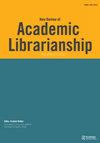Figuring embedded librarianship: An analysis of the embedded journalist metaphor in the professional discourse
IF 2.3
Q2 INFORMATION SCIENCE & LIBRARY SCIENCE
引用次数: 0
Abstract
In the wake of the COVID pandemic, many academic libraries sought virtual instruction options, like the embedded librarian model, bringing renewed interest to the topic. Debates defining embedded librarianship are plentiful and varied, but a review of the professional literature reveals a commonly used metaphor comparing embedded librarians to embedded journalists. This paper analyses the prevalence of that metaphor in the professional discourse through the lens of cognitive metaphor theory (CMT) to reveal the semantic and pragmatic implications of its use. CMT highlights the power of figurative language to reflect and define professional identities. The metaphor’s militaristic rhetoric counters negative stereotypes of librarians as passive or meek, while the metaphor’s combative rhetoric discloses complex power dynamics between academic librarians and faculty. However, the etymology of ‘embed’ reveals more productive definitions related to geology, computer science, and linguistics. Embracing these multiple definitions will help librarians shape that role in the future. [ FROM AUTHOR] Copyright of New Review of Academic Librarianship is the property of Routledge and its content may not be copied or emailed to multiple sites or posted to a listserv without the copyright holder's express written permission. However, users may print, download, or email articles for individual use. This may be abridged. No warranty is given about the accuracy of the copy. Users should refer to the original published version of the material for the full . (Copyright applies to all s.)塑造嵌入式图书馆:专业话语中的嵌入式新闻隐喻分析
在新冠肺炎疫情之后,许多学术图书馆寻求虚拟教学选项,比如嵌入式图书管理员模式,这让人们对这个话题重新产生了兴趣。定义嵌入式图书馆员的争论很多,但对专业文献的回顾揭示了一个常用的比喻,将嵌入式图书馆员比作嵌入式记者。本文从认知隐喻理论的角度分析了该隐喻在职业语篇中的普遍性,揭示了其使用的语义和语用含义。CMT强调形象语言反映和定义职业身份的力量。隐喻的军国主义修辞反驳了图书馆员被动或温顺的负面刻板印象,而隐喻的好斗修辞揭示了学术图书馆员和教师之间复杂的权力动态。然而,“embed”的词源揭示了与地质学、计算机科学和语言学相关的更富有成效的定义。接受这些多重定义将有助于图书馆员在未来塑造这种角色。[发件人]《学术图书馆学新评论》版权归劳特利奇所有,未经版权持有人明确书面许可,不得将其内容复制或通过电子邮件发送到多个网站或发布到列表服务。但是,用户可以打印、下载或通过电子邮件发送文章供个人使用。这可能会被删节。对复印件的准确性不作任何保证。用户应参考材料的原始发布版本以获取完整信息。(版权适用于所有人。)
本文章由计算机程序翻译,如有差异,请以英文原文为准。
求助全文
约1分钟内获得全文
求助全文
来源期刊

New Review of Academic Librarianship
Social Sciences-Library and Information Sciences
CiteScore
3.40
自引率
0.00%
发文量
20
 求助内容:
求助内容: 应助结果提醒方式:
应助结果提醒方式:


